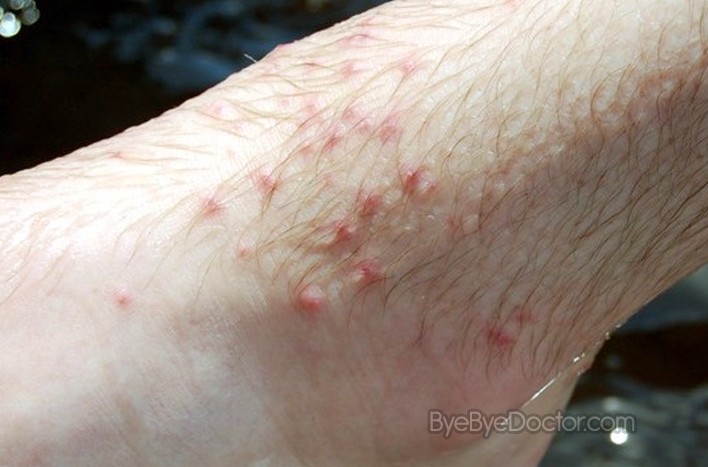Chigger Bite
Last reviewed by Dr.Mary on August 7th, 2018.
What exactly is a Chigger bite?
Basically, it is a bite from a chigger which is an incredibly tiny larva that is parasitic as well as red in color. The larva is of the scrub mite or harvest mite, also named as the red mite. It is a hazard to reptiles, birds as well as a range of mammals as well as humans. Nymphs, as well as the adult harvest mites, usually are not harmful to humans. But, it’s the chigger larvae that create skin and health problems. The chigger isn’t an insect but instead is a member of the spider family known as the arachnid.
Chiggers need nutrients so that they can advance to the nymph stage. This is done by getting food from animals and humans. Chiggers fasten themselves to humans near a pore in the skin or follicle for hair, and it is then that they inject an enzyme for digestion in the skin. This enzyme ruptures the cells of the skin. The skin responds to this development by hardening the cells on all sides and because of this a tube structure which is hard and referred to as a “stylostome” is formed. The stylostome is a tube for feeding. In this way, the chiggers suck out the skin cell fluid. As they are attached to the skin, the chiggers are continually injecting saliva which liquefies new tissue and continues to suck up the fluid. This entire process starts a wide variety of conditions of the skin and for this reason treatment for bites from chiggers is needed.
When the chiggers finish feeding, which can take from 1 to several days( most commonly 3 to 4 days), they will leave the host and then grow into nymphs.
Chigger Bite Symptoms
Treatment for bites of the chigger is often required to ease the indications that occur after the bite. In a first few hours after the bite, severely intense itching of the skin will begin. This will be accompanied by the emergence of bumps which are red on the skin. In time, more and much larger hives, bumps or welts become noticeable. The symptoms of itching will generally get worse and can last a long time since the chigger is continually injecting saliva into the skin to continue feeding, and the skin responds to this saliva.
As soon as the chigger has finished eating which is after a few days, it falls off. But the feeding tube is left in the skin. This tube is identified as a welt which is red and has a hard, white central area that may become dermatitis. What individuals usually note in the center of the hive is the tube and not the chigger body.
This feeding tube or stylostome will continue to cause skin irritation even without the chigger. The skin keeps on being intensely itchy as well as to contain welts or hives. The more amount of time the chigger was feeding, the deeper the feeding tube go through and therefore more the relentlessness of the symptoms. These symptoms because of the feeding tube may continue for 2 to 3 weeks. Scratching the cap which is dried off of the top of the feeding tube can cause some liquid to leak out as well as form a possible infection.
When it comes to diseases, North American chiggers usually do not pass on any disease, so a typical treatment for chigger bites is all the treatment that is needed. But, in Eastern Asia as well as the Southern Pacific regions, a bite from a chigger often leads to a disease known as “scrub typhus” – which is also known as “scrub disease,” “tsutsugamushi” or “Japanese River Disease.”
The symptoms of Chigger Bite disease include:
- Fever
- Headache
- Muscle pain
- Cough
- Gastrointestinal problems
Chigger Bite Treatment
The best treatment for chigger bites is first to eliminate the chiggers immediately. This will decrease the relentlessness and time of the symptoms. The chiggers can also be detached by showering with soapy warm water. In fact, even light chafing of the skin with a cloth or towel is sufficient to eliminate the chiggers. Other symptoms which will develop include:
- Itching
- Hives
- Welts
- Skin redness
These symptoms can be comforted by using the standard treatments for these symptoms. These treatments usually involve using antihistamines or hydrocortisone creams. There are furthermore available on the market as commercial products only for treatments for bites from chiggers.









If the chigger is a member of the arachnid family then why does it have only 6 legs like insects.?
Lisa, the blisters did not appear as rounded and fat as I see in the graphic..
picture,did it change that much?love
I think I may have chiggers but my parents think its an allergic reaction to something else. Chiggers happened to my dad one time. He was cured with a medicine fron Wal Mart. It looks disgusting and I feel like puking when I see myself. I hope I get cured soon… XP
Hydrogen peroxide works and original listerine helps the itching. Really HOT water helps too.
I usually use tea tree oil but I tried the hydrogen peroxide last night and got up
this morning and they were twice as big as when I went to bed. I went back to
the tea tree oil. but haven’t got the size reduced yet.